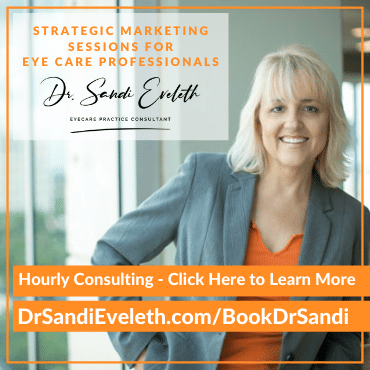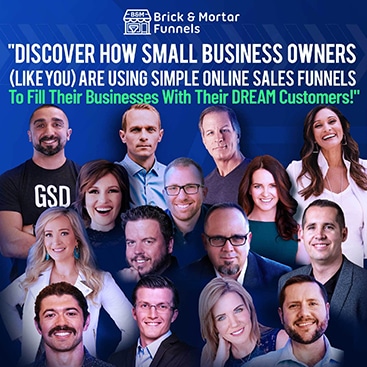
Discover how to get more patient referrals from sources in your community that your competition will never even consider.
The “Usual Suspects”
Whether you’ve been in practice for decades or for a very short time, you know the importance of establishing relationships with other healthcare professionals that could refer their patients to you for the specialty products and services you provide.
In fact, it’s one of the most profitable ways to attract patients into your specialty practice…
So, let’s start with what I call the Usual Suspects (here’s a list of your typical referral sources)…
- Other optometrists: When you offer a (sub)specialty they don’t include in their own practice, this is one of the best (and easiest) referral sources you can acquire. There is no other profession that understands what you offer, and how well you’ll take care of their patients (including sending them back for all other products and services – see below for more on this), than your colleagues. Don’t take them for granted!
- Ophthalmologists: Yes, I know. You may think, there’s no way they’ll refer patients to ME! But, guess what, some will. Our practice received many referrals, including routine contact lens fits (there are many ophthalmology practices that do not like to fit contacts!), specialized contact lens fits, vision therapy (we even had an ophthalmologist send his own child through our VT program), low vision (think, retina specialists!), computer vision syndrome, and more…
- Primary Care MDs/DOs: Once you develop a professional relationship with primary care physicians in your community, they may refer to you their: diabetic patients, hypertensive patients, and many other patients that present with systemic conditions for which we can monitor their vision and eye health status. By demonstrating that optometrists are the true gatekeepers of eye care, primary care physicians will make these referrals.
- Pediatricians: Once you let your local pediatricians know that you specialize in vision therapy, sports therapy, and myopia control, they will eagerly refer their pediatric patients to your practice.
- Chiropractors: Since chiropractors holistically treat many of the same patients in your community that would benefit from your (sub)specialties, such as diagnosing and managing computer vision syndrome, it would make perfect sense for them to refer to you.
- Podiatrists: A fair amount of podiatrists treat diabetic patients. Their patient base is definitely YOUR patient base.
- Dentists: Dentists are a great source of referrals that are often overlooked. And, as a whole, they are a profession that knows how to effectively market to their communities. Once you demonstrate your passion for helping their patients look their best, too, such as by fitting them with contact lenses to go along with their brand new smile, they’ll happily start referring their patients to you.
- Teachers/School Principals/School Nurses: Although these professions may seem obvious, you’d be surprised that they are often never contacted by local optometrists! We acquired most of our professional referrals into our vision therapy practice from our local schools in the community directly from school nurses, teachers, and principals.
Great Ideas from The Clubhouse Room Discussion
The ideas were flying in our Eye Care Marketing CLUB room today! Here are some of those gems:
Warren is the CEO & Co-Founder of Neurodynamic Vision, a company created to help potential patients understand the power of the brain to improve overall human performance (as described on his website). I was so impressed with Warren’s knowledge on the subject, especially since I was co-owner of a private optometry practice that specialized in vision therapy.
His commentary on how optometry needs to set itself apart as a more holistic profession teaching the community at large how we can dramatically enhance the lives of our patients, in so many more ways than ever thought possible, was profound.
It also served as a reminder of how we need to promote our (sub)specialties as much as possible.
Here are some of Warren’s ideas on other Referral Sources (and more):
- Look for local companies that work with athletes for your vision therapy practice
- Offer to perform initial performance and vision screenings that serve as a baseline evaluation for the team and individual coaches
- Demonstrate how you can enhance their performance with your sports vision therapy
- Look at your passion and find something unique to separate yourself, then demonstrate that with…
- local micro-influencers
- Your “Unique Selling Proposition (USP)” will be easy to promote…
- It’s totally different than the routine eye exams your competitors are marketing
- Start thinking about it in terms of “performance VT” – visual performance and clarity begin in the brain! Your marketing messages would include: PERFORMANCE VISION; “Vision Starts in the Brain”
- Possible ideal patient avatars/humans
- High School and College-student athletes; any age professional athletes; any age (including retirement) amateur athletes – dramatically improve their abilities and competitive standings
- Coaches, trainers, etc. that work with all of the athletes listed above
- Online gamers
- Under-served communities
- Other ideas and discussion
- Provide and promote community screenings that involve more than the typical screenings; provide information for how you can improve a person’s overall performance with your (sub)specialty
- There is no substitute for this in the artificial intelligence (AI) arena
- Promote and educate about “Brain health”
- How can you use your eyes to calm your mind?
- How can you use your eyes when gaming?
- How can you use your eyes more effectively?
- Economic value – Profits can be dramatic when you add customization to your practice in the form of (sub)specialties – they add value dramatically
- We must learn how to guide a transformation from where our patients are to where they want to be – guide them to be better than they are
- “Staging” – We must learn how to increase the entertainment and experience value before, during, and after their visit with us; when patients have a memorable experience with us, that’s the highest level of patient care we can provide.
- We haven’t really evolved over the decades in the profession of optometry in our ROUTINE eye exams… that needs to change!
- Every practitioner needs to understand the patient’s journey BEFORE they ever enter the exam room. This includes:
- How they heard about you,
- What kinds of problems they have and how they are searching for solutions to these problems,
- Where they hang out online,
- How they speak,
- What’s important to them,
- Who’s important to them,
- What they do for a living and for fun,
- What they expect from their first interaction with your office (do they get a live person or a recording; can they book an appointment online, or do they have to call your office?),
- What they expect from your exam, staff, safety precautions, recommendations, and more,
- What they perceived about the overall eye exam appointment and check out procedures,
- How much you cared about them, helped them, addressed their chief complaint, and solved their issues with your products and services
Fayiz is the Founder of Augmented Vision Labs, and founded the company to explore ways of applying emerging technologies such as additive manufacturing, artificial intelligence, spatial computing, and cloud computing to the delivery of eye care. He is a strong believer in the power of these technologies to revolutionize eyecare and is focused on helping accelerate that process through Augmented Vision Labs™ (taken directly from the website).
Here are some of Fayiz’s gems from the room:
- Find referral sources that work with patients who have experienced concussions; there are numerous ways we can help improve the quality of these patients’ lives
- Start with referral resources that understand the additional (sub)specialties we provide
- Become active allies with other professions in our communities that work with these patients
- For example: Occupational Therapists, Physical therapists, Geriatric (stroke) physicians, etc.
- Promote your capabilities by giving live talks, webinars, etc
- Explain the differences and collaboration of Functional vision + medical technology
The “Secret Sauce”
These are the referral sources most eye care providers never even consider that, quite often, turn out to be some of the most lucrative (think 80/20 principle!)
The following list is grouped by the type of (sub)specialty product(s) and service(s) you may offer
Remember: (Sub)Specialty Services attract unique referral sources – “think outside the box…”
- VT/Sports VT/Myopia Control/Ortho-K
- Teachers/School nurses/principals (as mentioned previously) – also consider starting with private; public schools may not allow for direct referrals
- Homeschooling organizations
- Local sports teams/clubs
- youth and adult (eg. Baseball, softball, football, basketball, tennis, soccer, equestrian, swimming, etc.)
- Gun clubs/target shooting/hunting clubs
- Sporting goods stores
- Centers for sports enhancements
- Gyms
- Health coaches, Life-coaches
- Pickleball organizations – this is quite the rage these days
- VT/Sports VT device companies
- Local bloggers, podcasters, news media journalists that typically report on these topics (often, your local public relations organization or digital marketing agencies will have a list of the right people to contact)
- Gamers/local gamer organizations
- Don’t forget to check local meetup.com groups that pertain to any of the above
- Low Vision
- Retina specialists (of course)
- Assisted living facilities, etc nurses/administrators (“All Eyes” “Notal (?)” – VR testing)
- Local Lyons Clubs
- Lighthouse for the blind
- Medical supply stores – canes, etc.
- Low vision device companies
- AARP, etc
- Local bloggers, podcasters, news outlets on these topics
- Specialty CL Fittings
- Gun clubs
- Archery clubs
- Golf stores/courses
- Fire chiefs/Police chiefs
- Schools (myopia control) – nurses, admins, superintendents
- Local bloggers, podcasters, news outlets on these topics
- Computer Vision Syndrome
- Local small business owners
- Computer training centers
- Call centers/Telemarketers
- Homeschooling associations
- Schools
- Vocational/Technical schools
- Local bloggers, podcasters, news outlets on these topics
- Dry Eye
- Beauty salons
- Cosmetic counters in high-end retail stores
- Pharmacists at local retail outlets
- Local bloggers, podcasters, news outlets on these topics
- Specialty Eyewear – think about the referral sources that would potentially refer to you for these specialty products
- Sports eyewear (polycarbonate, specially tinted lenses, special designs, lower seg heights, add on top and bottom, etc.)
- Same as VT above
- Scuba diving clubs (specialty masks)
- Magnifiers, etc. – special devices for LV
- Same as LV above
- Office supply + hardware stores
- Scleral Lenses
- Optometrists that don’t provide these lenses
- MDs/DOs specializing in trauma care
- Trauma surgeons
- Ortho K Lenses
- Pediatricians – referring for myopia control
- Occupational – occupations where the wearing of contact lenses or glasses may be hazardous to wear during the working hours
- Advanced Cosmetic Contact Lenses
- ODs/MDs/DOs that want to refer for photophobia issues from irregular pupils, iris issues, or irregular corneal issues like scarring
- Sports eyewear (polycarbonate, specially tinted lenses, special designs, lower seg heights, add on top and bottom, etc.)
The VIP Program
I wanted to deviate from the topic for a moment…
During the time I was co-owner of our private practice, we launched a successful campaign called the “VIP Program.”
We created it for local small business owners that didn’t have the budget to offer vision insurance to their employees. Here’s how it worked:
- The employees were offered a straight 20% discount on all products and services across the board.
- We contacted local small business owners either in-person, via mail, or email with a well-designed information packet to let them know what the program entailed for their employees.
- The owners would recommend the program to their employees, then we’d ask their employees to mention their employment discount upon scheduling, and then, upon arrival, they were asked by our front desk to prove their employment with the company either via a letter from us or a membership card we created.
- They would then receive their discount upon check out.
This became a referral source of sorts as we signed up more and more companies to the program, and the owners would refer into our office their employees.
The Plan, Connection, Development, and Nurturing Phases
OK, so NOW what? HOW do we initiate these connections, get them to refer to us, and keep them in the loop about their patients?
The following is, what I like to call, the Professional Referral Program. It’s a system to help you make a plan to build your referral sources, find the most likely referrals, keep track of them, create an outreach plan, receive the referrals, build a process for communicating the patient care you provide back to the referral sources, and, lastly, nurture the relationships.
- The Plan
- Make a plan on how you’ll track your connections and follow-ups, and who is responsible for each step/phase of this and the following steps,
- Create an accountability calendar and make it available to all involved (sucxzh as with a shared Google Calendar)
- Create a spreadsheet or use a CRM (Customer Relations Management) software to build out and implement the plan (I use an app called Less Annoying CRM – the reason I opted for this particular CRM is in the name! I absolutely LOVE it. It’s also user-friendly on mobile devices. I am sharing with you my affiliate link to help defray the costs of this website). You’ll want to keep track of their names, addresses where you’ll send updated patient records if they are a healthcare provider, best work email addresses, best phone numbers, and their preferred method of correspondences. You’ll also want to keep track of whom they referred, when they referred them, and what correspondence you had with the referral source. IMPORTANT NOTE: Make sure to check with your attorney to find out what you’ll need to do to be able to correspond with the referral source so as not to violate HIPAA regulations.
- Begin to develop the connections and provide value before asking for referrals – ideas
- Send a handwritten letter
- Schedule a virtual or in-person lunch & learn session (adding a ton of value on how what your specialty is can help their “humans”)
- Deliver a gift basket
- Send a letter outlining the benefits you provide to your (their) patients, why you’re different and the only doctor in town who provides the (sub)specialty that will help their patients
- Have a mutual connection connect you and them
- Join local networking groups (in-person and online)
- Provide educational seminars for their patients that are relevant to them (in-person seminars and online webinars) – let it be known in your community the kinds of seminars/webinars you present
- Follow-up routinely
- Ask if they need more information to help them understand how your (sub)specialties will help their patients
- Ask if they need co-branded pamphlets or info packets to give to their patients
- Create an easy-to-implement referral packet and system (instructions, clarity of benefits, branded materials, etc) – include a Video USB branded business-card type (personalized or not), educational or introductory
- Have legitimate reasons for frequent touchpoints to nurture the relationship
- Make sure you’re sending proper, HIPAA-compliant communication when you DO provide patient care for their patients, and return them promptly to their care (if they are healthcare providers); if they are referred by anyone other than a healthcare provider, make sure to get their permission to send the referring source a thank-you care or other appropriate communication
Join Us on Clubhouse!
You’ll need to be on your mobile, then click on the link below to download the app (currently only on the iPhone or iPad operating system).
Access the Clubhouse Notes
Download the PDF Clubhouse Notes
How to Get More Patients from Untapped Referral Sources
Here’s the video of the Clubhouse notes:



Leave a Reply